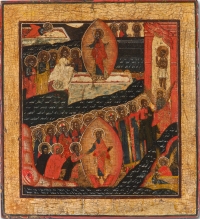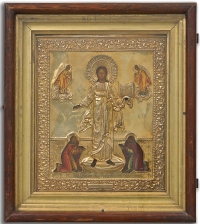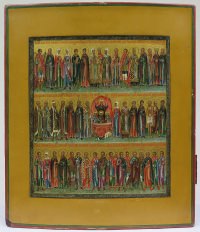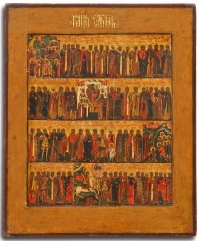A selection of fine icons from a distinguished collection in the USA.
16c Russian Icon of the Resurrection and the Descent into Hell (Anastasis)
A 16th-century icon depicting the Descent Into Hades and Anastasis (the Resurrection). Christ is shown in two scenes – above in the act of Resurrection and below in his descent into Hades, breaking down the doors of Hell, binding Satan and rescuing Adam and Eve. Behind them follow the kings, the prophets, and the righteous of the Old Testament, David and Solomon wearing the crowns, John the Baptist with the scroll in hand. Feast day: Easter Sunday.
- ID# 68-82-SSI-5
- Размер 30 x 25.5 cm
- Возраст около 16 век
- Происхождение Россия
- Материалы темпера на грунтованой доске
- Цена Цена по запросу
-

Икона - Спас Смоленский в серебряном окладе и киоте
An icon of the Savior of Smolensk in a gilded silver oklad revetment cover, Ivan Zakharov, Moscow, 1868, held in a glazed wood kiot shadow frame. The icon showing the Savior at full length with figures of the Venerable Sergius of Radonezh (left) and the Venerable Varlaam of Khutyn (right). His robes are chased and engraved in imitation of draped cloth and His applied halo pierced and engraved. The oklad’s borders are cast and chased with scrolling vines against a stippled ground.
Marks: Struck on the lower border and at lower left on the halo with maker’s mark, Moscow hallmarks with 84 silver standard (.875).
Condition: The icon with numerous minor areas of loss, inpainting, and discoloration. The oklad with minor dings, primarily to the borders.
- ID# 14-21-SSI-6
- Размер 31.8 × 26 cm
- Возраст около 1868 г.
- Происхождение Москва
- Материалы темпера на грунтованой доске, серебро, золочение
- Цена Цена по запросу
-

-

Fine Russian Icon - Selected Healing Saints
Icon with selected saints painted full-figured in three registers.
- ID# 81-SSI-4
- Размер 25.5 cm x 30.5 cm
- Возраст Ок. 1880
- Происхождение Палех
- Материалы Палех
- Цена Цена по запросу
Минейная икона на месяц Октябрь
A minea (calendar) icon for the month of October painted in the style of the famous icon-painting village of Mstera, the first half of the 19th century.
- ID# 47-66-SSI-2
- Размер 28.7 × 23.7 cm
- Возраст около первая половина 19го века
- Происхождение Мстера ?
- Материалы темпера на грунтованной доске
- Цена Цена по запросу
-

Не все артефакты, которые мы имеем в наличии, представлены на нашем сайте. Пожалуйста напишите нам, если вы ищете какой-то определенный предмет, но не видите его в нашем интернет – магазине.

Ознакомьтесь с гарантиями предоставляемыми клиентам нашим магазином.

Level 60 Trading Co,, LLC
1089 Commonwealth Ave #314,
Boston, MA 02215, США
Tel: (+1) 786-206-9894
Наше местное время
Онлайн Магазин
Информация
Быстрые Ссылки

Level 60 Trading Co,, LLC
1089 Commonwealth Ave #314,
Boston, MA 02215, США
Tel: (+1) 786-206-9894
Наше местное время







 Change language to English
Change language to English